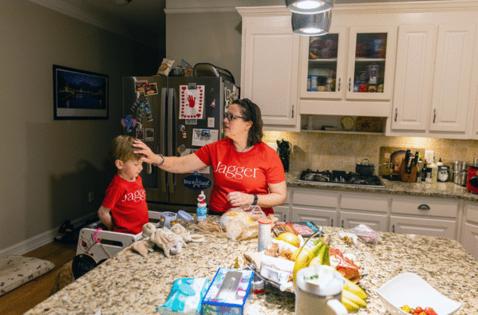Medicaid cuts would paint uncertain future for millions in Georgia
Published in News & Features
Medicaid is on the chopping block in Washington, D.C., and by extension throughout the rest of the country.
The cuts being pushed by Republicans in the U.S. House of Representatives would be felt in nursing homes, delivery rooms, doctors’ offices and private homes all over the nation.
Willie Barnett, 80, and his companions at the A.G. Rhodes nursing home in downtown Atlanta, have been asking each other what the cuts could mean for them.
They depend on Medicaid for health care, just like nearly 2 million other Georgians of different ages and situations.
For Barnett and his fellow residents, Medicaid pays for care in a nursing home. And they aren’t the only people relying on the government-subsidized health care program who face an uncertain future.
Medicaid is the government insurance program for low-income children and some other Americans, with costs borne jointly by the state and federal governments. Originally signed into law by President Lyndon Johnson, Medicaid has grown into one of the single largest insurance groups in the developed world, with 72 million beneficiaries.
Medicaid pays for nearly half of all births in Georgia. It covers 1.4 million children and 556,000 adults in the state.
Individual states decide with the federal government which groups its Medicaid will cover in addition to children, and Georgia has added some 30 eligible groups. They included poor nursing home residents who are on both Medicare and Medicaid, people federally declared disabled, low income new moms and adults who perform work or approved activities at least 80 hours a month.
At $16 billion in Georgia alone, where the federal government pays two-thirds of costs, Medicaid is a massive part of both the federal and state budgets. While the majority of the state’s enrollees are children, most of the money spent in Georgia is on care for the disabled and elderly, like Barnett.
But President Donald Trump and Republican leaders in Congress have committed to $1.5 trillion in budget reductions while extending tax breaks for corporations and the wealthy, as well as adding some new, broader tax cuts. Medicaid, one of the few spending pots big enough to help get there, could see cuts of up to $880 billion.
But Congressional budget-cutters are struggling to agree on specific targets because the program is widely popular with voters.
A plan floated this week would disenroll some beneficiaries and increase eligibility and paperwork requirements for millions of others, generating billions in savings by providing less coverage.
The measure held up through a marathon 26 straight hours of committee discussion from Tuesday through Wednesday. Having passed that committee and now heads to the House floor, and then potentially on to the Senate.
President Trump and fellow GOP leaders for weeks have avoided specifics on what they would cut from Medicaid. Trump has said: “We’re not going to touch it” except for fraud. But the plan he endorsed would require cutting health benefits for millions of people, experts say.
“Medicaid is an expensive program,” said Tim Layton, who researches health economics at the University of Virginia. “It‘s mostly expensive because health care is expensive. Medicaid itself is a pretty efficient.
“It‘s really unlikely it‘s going to be a good source for ‘free-lunch’ cuts. It‘s more likely to be cutting bone rather than fat, relative to other programs.”
Georgia Republicans aren’t eager to backfill any federal spending gap from state taxpayers.
“We’ll see how it plays out,” said Georgia House Speaker Jon Burns.
Georgia Senate Appropriations Chairman Blake Tillery said the impending federal cuts only vindicated the state’s years-long opposition to expanding Medicaid, starting a decade ago with Gov. Nathan Deal.
“It looks like Gov. Deal was right,” Tillery said, smiling.
According to a recent poll by the health research organization KFF, majorities of Americans have fundamental misunderstandings about what Medicaid does. In some ways they confuse Medicaid coverage with Medicare.
One of the biggest misunderstandings: Most people know Medicaid as the program originally set up to cover low-income children, especially since those children form the largest number of beneficiaries. But by far Medicaid’s most expensive patient group is elderly and disabled people.
Below are two cases where people’s lives were extended and their quality of life improved because of Medicaid.
Medicaid and nursing homes
Willie Barnett belongs to one of the largest and most expensive groups of Medicaid beneficiaries — people living in nursing homes. He came to the A.G. Rhodes nursing home on Boulevard after being in hospital rehab for a stroke.
Barnett said he was advised that he would need home care after rehab, but is single and lives alone. His family found him a slot at A.G. Rhodes, with the help of Medicaid.
Barnett, a former engineer, had long been signed up for Medicare, which pays for specific medical expenses but not general room and board at a nursing home. Medicaid does cover those living expenses.
“Overall, if it wasn’t Medicaid ... I wouldn’t have been able to stay,” he said.
At Rhodes, Barnett continued physical therapy. It was easier to keep up with it in the same facility where he lived. He met other residents with their own challenges, and started to make friends.
While nursing homes usually hope to slow their residents’ physical decline, it did more for Barnett.
The physical therapist urged Barnett to use his cane less and convinced him to try walking without it at all. It worked. She convinced him to walk unassisted to a sunny gathering area in the home several feet away. That worked, too.
Now, every day, he walks each of his facility’s five residential floors, taking the elevator in between. He greets the fellow residents, who sometimes point out he has left his cane behind without knowing it. He rides an exercise bike a few times a week.
Barnett is now president of the residents’ council, and acts as a go-between for residents and staff.
On a recent Friday morning, he walked all five floors and pedaled the exercise bike. Then, using his cane, he made his way to the social area for bingo.
Barnett says if he had gone home or to a relative’s house he would have most likely spent most of his days in bed, and died sooner.
Dr. Ted Johnson, a former nursing home director and chairman of the Department of Family and Preventive Medicine at Emory University, said that rings true.
“I think that‘s realistic,” Johnson said. “Aging is tough.
“If you keep going far out enough, everybody’s going to die eventually. At the same time, what we’re trying to do is prevent decline, provide structured rehabilitation services, and get people who really do want to make it back home able to accomplish that.”
Most residents don’t want to go to a nursing home, Johnson said. But if their health care needs are too great, Medicaid offers the flexibility to choose a nursing home.
“I think that for folks who find their circumstances such that they really can’t get by without assistance, that these facilities can provide meaningful care,” Johnson said.
About 74% of Georgia nursing home residents pay for their bed with Medicaid, according to the nursing home advocacy group the Georgia Health Care Association‘s data on its own members.
Barnett said possible Medicaid cuts have been a topic at the home.
“I don’t know what I’ll do if something happens,” he said. “I’ll have somewhere to go. But I wouldn’t have a way to live. I wouldn’t have a way to take care of myself.
“I don’t have a flashy life,” Barnett said. “But I have a life.”
Medicaid and the waiver
Twenty miles away from Barnett‘s nursing home, the Cotte family represents a different way Medicaid funding helps families. And just like Barnett, Medicaid helped give the Cottes a choice.
Jagger Cotte was 1 year old when he was diagnosed with Leigh syndrome, a mitochondrial disease. Over time, the disease essentially destroys the nervous system. It causes intense pain. The average life span is three years.
At the beginning, Jagger didn’t need Medicaid. His parents, Sebastien and Annett Cotte, have good private health insurance.
Eventually, though, as his nervous system broke down, Jagger needed more intensive care — and more than the family’s health insurance would provide on its own.
Georgia’s Medicaid program sets aside money to help fill gaps for severely disabled people. Jagger was in a niche group, called a “waiver.”
One by one, Congress and the states have added on groups of needy patients for Medicaid to cover.
In Georgia, there are dozens of such niche groups ranging from low-income new moms to low-income adults who work specific jobs, all at different income levels. Many of the groups have waiting lists.
Medicaid’s biggest population by far is low-income children.
But Jagger’s family isn’t poor, and they did not want him in a nursing home. Instead, they wanted him in their home to receive both the lifesaving interventions and hospice-level comfort care with strong painkillers that he needed.
Jagger was approved for a group where Medicaid supplements private insurance without requiring the family to spend all their other assets before qualifying.
The Medicaid benefits helped pay for crucial things that kept Jagger living at home. He needed equipment to keep him breathing, IV supplies, and special chairs to hold his head up, or his body in the bath or the car. Medicaid helped whenever insurance wouldn’t pay 100%. With those expenses paid for, the Cottes on their own bought a home generator in case the power failed.
There were still things the equipment couldn’t do, like keeping his airway clear when it became clogged with mucous. Sebastien and Annett suctioned Jagger’s throat 20 to 30 times a day and night.
They had an ace team of nurses make weekly home visits, with private insurance and Medicaid paying.
The extraordinary care Jagger received from his parents, thanks in part to Medicaid, added a decade to his life. Jagger died one year ago, at age 13.
“His parents provided exemplary care which enabled him to live longer than expected,” said his geneticist, Dr. Fran Kendall, adding that many parents would not have been able to do that.
“Other care providers in the same setting likely would not have been as successful in managing his health,” Kendall said. “His parents selflessly sacrificed their own lives and well-being for Jagger’s care, providing 24/7 intensive intervention as needed.”
Over the years, Jagger’s father estimates Medicaid contributed tens of thousands of dollars to Jagger’s care.
The needs were so heavy that the family never got a good full-time caregiver to stay.
Annett and Sebastien never left Jagger alone, never leaving home together without him, so one of them would always be with Jagger.
Because Jagger lived so long, he met his brother, Jovi, now age three. Jagger is gone now, but not for Jovi. When he takes a plane ride, Jovi says they will see Jagger because his brother is in the sky.
Annett and Sebastien’s bedroom, where Jagger slept, is no longer the center of gravity all day. Little by little they are still getting rid of the equipment Medicaid helped fund.
Jagger never managed to speak or eat food, but his parents say that by living with him they knew and felt him as strongly as any family member.
They still haven’t come to terms with his loss.
“He was my person,” Annett said. “The connection I have with him, it‘s hard to explain. He didn’t ask to be sick, he didn’t deserve that. We tried the best we could. At what point do you give up?”
With insurance and Medicaid, she said, “We were at least, we felt, able to give him the quality of life we could.”
©2025 The Atlanta Journal-Constitution. Visit at ajc.com. Distributed by Tribune Content Agency, LLC.










Comments